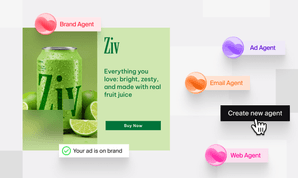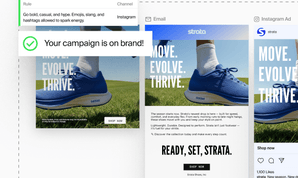AI at Work
Breaking Retail’s AI Paradox: Insights from the Typeface Signal Report

Typeface
November 4th, 2025 · 4 min read

Retail marketing is at an inflection point.
Everyone is demanding more content. Campaigns need to move faster. Personalization must go deeper. AI was supposed to make all of this easier — yet most teams are still struggling to translate adoption into acceleration.
To understand why, Typeface surveyed senior marketing leaders across the retail industry. The findings reveal a clear paradox: AI adoption is nearly universal, but productivity gains remain limited.
Content demand continues to accelerate
Every retail marketing leader surveyed (100%) said demand for content is increasing — unsurprising given the constant cycle of seasonal campaigns, omnichannel activations, and personalized customer touchpoints. Still, only 58% say their teams have the resources to meet that demand.
The result is a widening execution gap. 72% of retail marketers report that launching a multi-channel campaign takes three to four weeks, even though 86% want to move twice as fast. Despite widespread AI experimentation, campaign velocity has not yet caught up with campaign ambition.
AI adoption is high, but transformation is uneven
83% of retail marketers have adopted AI in some capacity. However, 76% remain in pilot phases, and most AI use (72%) happens at the individual level rather than through collaborative systems or platforms.
These isolated deployments create what many leaders describe as “productivity islands” — small efficiency gains that don’t scale across teams. The opportunity now lies in connecting these efforts through systems that enable orchestration, governance, and shared acceleration.
“Retail marketers aren��’t short on tools — they’re short on time,” says Jason Ing, Chief Marketing Officer at Typeface. “AI can absolutely accelerate how campaigns are built and personalized, but only if teams reimagine the way they work and trust the systems that connect it all. This isn’t about more tech; it’s about better orchestration.”
Budgets are shifting, but ROI remains under pressure
AI is already changing how retail marketers allocate budgets. More than half (51%) have reduced external agency spend on content creation in the past year due to AI — but those savings are being redirected toward internal enablement and creative strategy.
Still, 96% of marketing leaders say they struggle to justify marketing spend to internal stakeholders, and more than a quarter say they struggle significantly.
The data points to an industry in transition: AI is cutting costs, but not yet improving productivity.
“When AI is used in silos, you get faster outputs, not better outcomes,” adds Ing. “The real unlock comes when AI becomes embedded in how teams plan, create, and collaborate. That’s where speed and creativity finally meet at scale.”
Personalization leads the way
One area where retail marketers are ahead is personalization.
65% say they already personalize campaign content for each segment, and nearly all do so for at least some segments. The potential for differentiation is clear — when AI is scaled effectively, personalization becomes both faster and more relevant.
This represents the shift from isolated AI use cases to integrated systems that drive measurable impact across teams and markets.
Breaking the paradox
The data tells a consistent story: AI has moved from experimentation to expectation, but its full potential depends on orchestration. There’s no question that AI can help. Now, the key is understanding how to make it scale.
To break the paradox, leaders must:
Build systems that connect AI to brand data, governance, and workflows.
Move beyond pilots to organization-wide deployment.
Focus on orchestration over tool expansion.
Invest in internal capabilities as agency spend declines.
AI’s promise in retail marketing isn’t just faster content — it’s smarter coordination. When creativity, data, and systems align, retailers can deliver campaigns at the speed and scale today’s market demands.
Download the Signal Report: Retail Edition
About this research
This research is part of The Typeface Signal Report — an industry insights series spotlighting the signals redefining marketing in the age of AI.
Read the full Typeface Signal Report.
Share
Related articles

AI at Work
Typeface Signal Report: What are Top Marketing Leaders Saying about AI Adoption?

Typeface
October 1st, 2025 · 7 min read

Product
Introducing Typeface Arc Agents

Jason Ing · Chief Marketing Officer
September 16th, 2025 · 6 min read

Product
Introducing Brand Agent: Unlocking Real-time Brand Governance

Saachi Shah · Product Manager
October 21st, 2025 · 4 min read